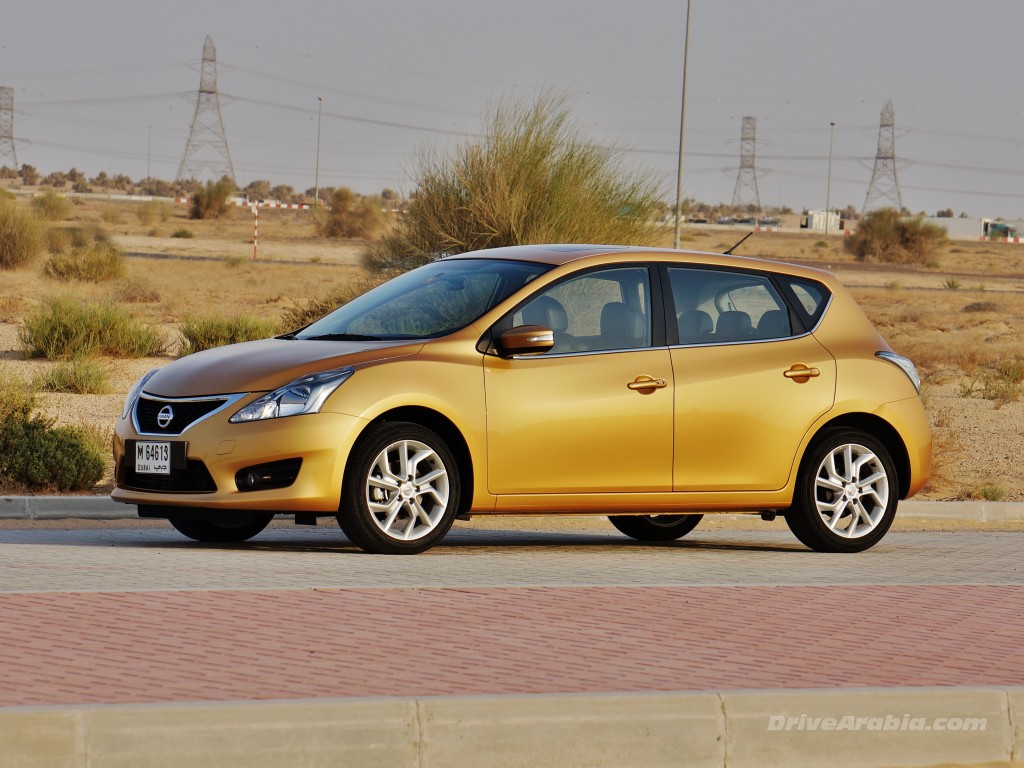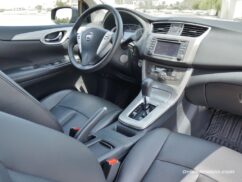2014 Nissan Tiida 1.8 SL

| The Good: – Great fuel economy – Cabin space and features – Decent ride quality |
The Bad: – Bit pricey with options – Noisy on acceleration – Some hard cabin plastics |
Most mass-market cars get a major revamp every four years, in an attempt to upstage each other. It’s only expensive stuff, like the Range Rover or the Lamborghini Gallardo, that can get away with stagnant development. And then there’s the Nissan Tiida. The last time we tested one was when it was a freshly-launched 2006 model, and we were still in college, doing this website thing part-time. It was a 1.6-litre hatchback, and for some unfathomable reason, the dealer gave it to us upstarts for almost a week. It was fresh and modern at the time. We actually fell in love with it on the back-and-forth trips to the garage where our 15-year-old jalopy was getting fixed. Since then the Tiida has remained virtually unchanged for more than seven years! Stagnation might be frowned upon with some cars, but the Tiida proved that there’s a market for cars that just do what cars are meant to do — move people around reliably — without the fanfare of a new tech-laden model every few years.
But now the 2014 Tiida is all grown up, just like us, and aiming to be that very tech-laden new model. Nissan has chosen to pass the entry-level torch off to their Micra and Sunny models, moving the Tiida into a higher segment with a 100 mm longer wheelbase, and moulding it with an attractive skin to boot.

The cabin is a step up from the old model as well, even more spacious than before, and making use of more premium materials. The entire dashboard is shared with the Sentra, with which the new Tiida also shares its drivetrain and platform. The only difference here is that the Tiida gets an all-black colour scheme as well as a standard touchscreen on nearly all trim levels, apparently to appeal to the “youths” more. The upper half of the dash as well as the front door-inserts are soft-touch, and all arm-rests front and back are padded. The upper bits of the front doors are hard-plastic though, as is everything below the waist as well as almost the entire rear door-panels, more so than in the Sentra.
There are no complaints in terms of space though. There’s enough room in there to rival midsize sedans, both front and back, which makes it much more spacious in the back than rivals such as the Chevy Cruze, or even larger cars like the Cadillac CTS. The front seats are moderately bolstered, and look good in our top-spec tester’s leather upholstery. The boot is of a decent size for a hatchback, and even has a split-folding rear bench, although the boot floor is much shorter in length than that of the Sentra sedan.
All except the basic trim come with a resistive touchscreen that integrates navigation, stereo functions, Bluetooth phone, and even a rear camera. It’s slow at things like loading “points of interest” in the nav, but is quick enough in most other functions. There’s also smart keyless entry with starter button, power windows and mirrors, fog lamps, two front airbags with optional side and curtain airbags, decent CD/MP3 stereo with USB/AUX ports and more. Our top-spec model came with a good dual-zone auto a/c, and even rear vents are standard.

While there are two engines on offer, a 1.6-litre and a 1.8-litre, ours was the bigger motor, making an unremarkable 131 hp at rpm and 174 Nm of torque. The big news is the standard CVT automatic for all models, an annoying piece of engineering that makes for noisy acceleration, but also improves acceleration and fuel economy. We clocked our fresh-engined car at 11 seconds in the 0-100 kph run late August, matching the new Honda Civic while outrunning the Chevy Cruze. However, we clocked a Sentra at 9.7 seconds in cooler weather, so we believe there’s more juice in this motor yet. Even with all the pounding, it managed to burn only 9.6 litres/100 km as per the trip computer, not really surprising considering it does only 2000 rpm at 120 kph.
The gearless transmission can occasionally feel lazy, but can be overcome by shifting to either “low” or “sport” mode, both of which seem to pump the revs high at the slightest touch of the throttle, while embarrassing yourself in the middle of traffic with all that engine noise as you hustle away.
The Tiida still offers relatively good refinement on the highway, with a ride almost as smooth as a firmly-sprung BMW 3-Series, that too using just a front strut and rear torsion-beam setup. Our tester had 17-inch alloys with 205/50 tyres, but the lower-spec models with smaller wheels and higher-profile tyres are likely even smoother. Unfortunately our specific test car had some sort of wind noise issue, otherwise it’d probably be as quiet as the impressive Sentra.
The Tiida’s handling is not as sharp as that of the class-leading Focus, but it still manages to be better than a Toyota Corolla. Body roll is noticeable, but never excessive, and there is no bouncy rebound as you straighten out after a sharp turn. The tyres offer good grip, especially with the wider rubbers on our top model. But the limits are still within reach, where the car safely understeers and goes wide cleanly, with no weird snap-oversteer on sudden directional transitions, even with the optional ESP off. It’s not exciting, but it’s always safe.
Maybe it’s just our imagination, but the power-steering tuning seems to be a bit different from the Sentra. The Tiida’s one is light, but ever-so-slightly heavier and less springy than the Sentra’s one. However, the wheel offers almost no feedback. Still, city-driving is a breeze, especially in parking, that too with the aid of rear sensors and a camera with straight guiding lines, which some pricier cars don’t even have. We also liked how responsive the foot-controls are, with no throttle delay in most cases, and a brake pedal that offers a little weight and nice linear application. The standard ABS-assisted brakes themselves are also surprisingly good, even with only rear drums backing up the front discs. There is a tendency for the rear to snake around by a little bit under hard stops, a characteristic of cars with rear drum brakes, though it is much less than in, say, the smaller Honda City.
The latest Nissan Tiida is a much nicer car than the one it replaces. It’s also a more attractive alternative to the Sentra, but we’re not sure how many “youths” really pine for a Tiida rather than a GT-R. If what you really want is space and practicality, but with the same level of performance, the Sentra is a better option for a slightly lower price. Let’s look at it this way -– if we were in the market for an affordable commuter car, we’d go for the prettier Tiida ourselves, but if anyone asked us what car they should go for, we’d tell them to buy the Sentra every single time.
| Price Range: Dh 69,000-82,100 Current Model Introduced in: Body Styles: Engines: Transmissions: Setup: Suspension: |
Brakes: Front: discs Rear: discs Curb Weight: Length: Wheelbase: Top Speed: Test Acceleration 0-100 kph: Observed Test Fuel Economy: |
















Comments
SAMER
notice that the fuel economy rate you got it this review is the same you got for the CAMRY 2013 with a 2.5L Automatic transmisson engine
it means that either this car consumes so much gas, or the camry is super economic!
Mashfique Hussain Chowdhury
Anything under 10 l/100 km is good in our book. However, this car wasn’t properly broken in yet. The Sentra we drove earlier with the same engine got around 7.5 l/100 km!
Joe
The 1.8L is a bit overpriced.
Alla
True, 1.8 is a bit pricy, but 1.6SV is a very good choice compared with its competition
is it stable compared to previous models for driving between 120 to 140 kmph?
Mashfique Hussain Chowdhury
It’s fine at those speeds.
Nabeal
even previous tiida I have taken to 200. Always felt it stable at least 140. but the only problem is, if you don’t have a cruise control, its hard to maintain a speed.
Mufaddal
@Nabeal, you took the Tiida to 200…pretty amusing
Mohammed Osman
Older Tiida is horrible after 110 KM/H ! I thought everybody knew that 😐
Nabeal
your last line made me laugh.. friends usually ask me what car to buy specially who don’t know anything and just want to use a car to travel from work to home. Though I would buy anything else but I will always tell them buy a corolla (which has all the basics right and a resale)
Mohammed Sulaiman Al Nabuwan
I agree with you ….
Corolla is the best for all time
prado
at 80k you are better of buying a mazda 6 entry model…
Hansel
At 80K, I’d rather go for the Lancer GT or Cruze hatch that comes fully loaded as well.
I’m going to check this car out at the showroom today actually, hoping to be mildly surprised as compared to the earlier models. (Loving the alloys btw)